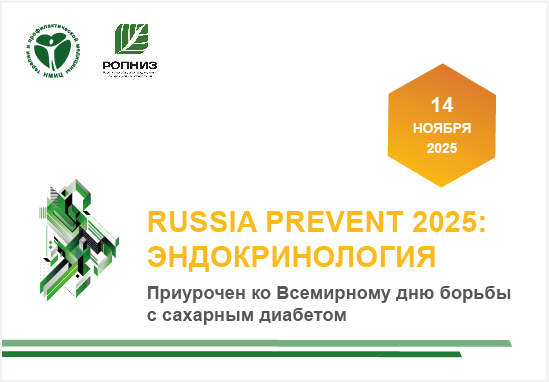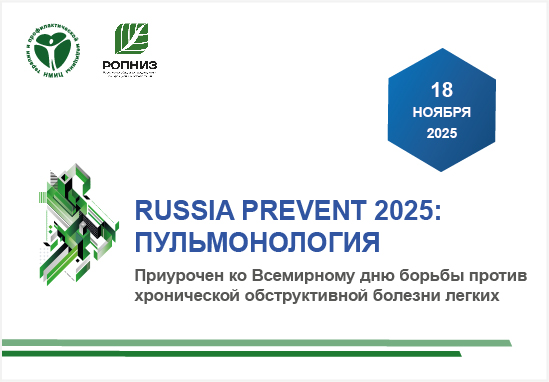Hysterectomy as a part of cardiovascular continuum
Abstract
Aim. To study the stages of metabolic disorder progression after hysterectomy (HE). Material and methods. In total, 104 women (mean age 44,0±2,1 years) after supravaginal hysterectomy with intact ovaries were examined. The participants were divided into three main subgroups, according to the time since HE (1 year, 3 years, and 5 years). The comparison group (CG) included 25 women (mean age 43,0±1,6 years). The levels of blood pressure (BP), blood lipid profile, immuno-reactive insulin (IRI) and C-peptide in plasma (fasting level and the level after oral glucose tolerance test) were measured. Results. Longer time since HE was associated with a significant increase in body mass index, systolic and diastolic BP, basal and stimulated C-peptide levels, basal and stimulated ITI levels, as well as in total cholesterol (CH) and low-density lipoprotein CH, comparing to the CG. There parameters were significantly and directly correlated with the time since HE. Conclusion. Metabolic disturbances were more pronounced in patients with longer time since HE. This allowed to specify the stages of post-HE metabolic syndrome and to justify the strategy for post-HE patients’ management.
About the Authors
V. I. PodzolkovRussian Federation
A. E. Bragina
Russian Federation
T. I. Nikitina
Russian Federation
N. M. Podzolkova
Russian Federation
References
1. Lepine LA, Hillis SD, Marchbanks PA, et al. Hysterectomy surveillance – United States, 1980-1993// MMWR CDC Surveill Summ 1997; 46(4): 1-15.
2. Кулаков В.И., Сметник В.П., Краснов В.Н. и др. Хирургическая менопауза (пособие для врачей). Москва 2003; 40 с.
3. Макаров О.В., Доброхотова Ю.Э., Любченко Н.В.. Некоторые аспекты результатов гистерэктомии у женщин репродуктивного возраста. Акушер гинек 2000; 3: 12-4.
4. Краснопольский В.И., Рубченко Т.И. Хирургическая менопауза (клиническая лекция). Пробл репродук 1998; 5: 76-80.
5. Доброхотова Ю.Э. Ливиал как средство реабилитации после гистерэктомии. Cons med 2003; 5(2): 62-6.
6. Luoto R, Kaprio J, Reunanen A, Rutanen EM. Cardiovascular morbidity in relation to ovarian function after hysterectomy. Obstet Gynecol 1995; 85(4): 515-22.
7. Мартынов А.И., Майчук Е.Ю., Юренева С.В. и др. Особенности формирования и течения артериальной гипертензии у женщин после тотальной овариэктомии. РМЖ 2004; 12(5): 352-6.
8. Здоровье женщин и менопауза. Пер. с англ. Москва “ГЭОТАР-МЕД” 2004; 528 с.
9. Kramer HM, Curhan GC, Singh A. Hemodialysis and Estrogen Levels in Postmenopausal Patients Study Group. Permanent cessation of menses and postmenopausal hormone use in dialysisdependent women: the HELP study. Am J Kidney Dis 2003; 3(43): 643-50.
10. Zeigler-Johnson CM, Holmes JL, Lassila HC, et al. Subclinical atherosclerosis in relation to hysterectomy status in black women. Stroke 1998; 29: 759-64.
11. Cole P, Berlin J. Elective hysterectomy. Am J Obstet Gynecol 1977; 129(2): 117-23.
12. Robinson RW, Higano N, Cohen WD. Increased incidence of coronary heart disease in women castrated prior to the menopause. Arch Intern Med 1959; 104: 908-13.
13. Centerwall BS. Premenopausal hysterectomy and cardiovascular disease. Am J Obstet Gynecol 1981; 139(1): 58-61.
14. Palmer JR, Rosenberg L, Shapiro S. Reproductive factors and risk of myocardial infarction. Am J Epidemiol 1992; 136(4): 408-16.
15. Lambert LJ, Straton JA, Knuiman MW, Bartholomew HC. Health status of users hormone replacement therapy by hysterectomy status in Western Australia. J Epidimiol Community Health 2003; 57: 294-300.
16. Hsia J, Barad D, Margolis K, et al. Usefulness of prior hysterectomy as an independent predictor of Framingham risk score (The Women’s Health Initiative). Am J Cardiol 2003; 92(3): 264-9.
17. Carlson KJ. Outcomes of hysterectomy. Clin Obstet Gynec 1997; 40(4): 939-46.
18. Аскольская С.И., Адамян Л.В. Гормональные изменения после гистерэктомии. Климактерий 2001; 3: 64.
19. Howard BV, Kuller L, Langer R, et al. Risk after cardiovascular disease by hysterectomy status, with or without oophorectomy. The Women’s Health Initiative Observation Study. Circulation 2005; 111(2): 1462-70.
20. Подзолков В.И., Подзолкова Н.М., Можарова Л.Г., Хомицкая Ю.В. Артериальная гипертензия в пери- и постменопаузе. В кн. “Медицина климактерия” под ред. Сметник В.П. Москва Издательство “Литера”; 462-75.
21. Подзолкова Н.М., Подзолков В.И., Никитина Т.И. и др. STEAR-терапия как метод коррекции метаболический нарушений после гистерэктомии. Пробл репродук 2005; 2: 81-6.
22. Ahn EH, Bai SW, Song CH, et al. Effect of hysterectomy on conserved ovarian function. Yonsei Med J 2002; 43: 53-8.
23. Макаров О.В., Доброхотова Ю.Э., Чернышенко Т.А.. Функциональное состояние яичников и метаболические изменения у женщин репродуктивного возраста после гистерэктомии. РМЖ 1998; 6: 26-9.
24. Biro JC, Eneroth P. Inhibitory effect of the uterus on plasma and pituitary FSH in rats. J Endocrinology 1990; 124: 183-9.
25. Подзолков В.И., Подзолкова Н.М., Никитина Т.И. и др. Гистерэктомия как триггер эволюции метаболического синдрома. Росс вест акушер гинекол 2009; 6: 60-4.
26. ESH-ESC Guidelines Committee. 2007 guidelines for the management of arterial hypertension. J Hypertension 2007; 25: 1105-87.
Review
For citations:
Podzolkov V.I., Bragina A.E., Nikitina T.I., Podzolkova N.M. Hysterectomy as a part of cardiovascular continuum. Cardiovascular Therapy and Prevention. 2010;9(3):73-79. (In Russ.)
























































